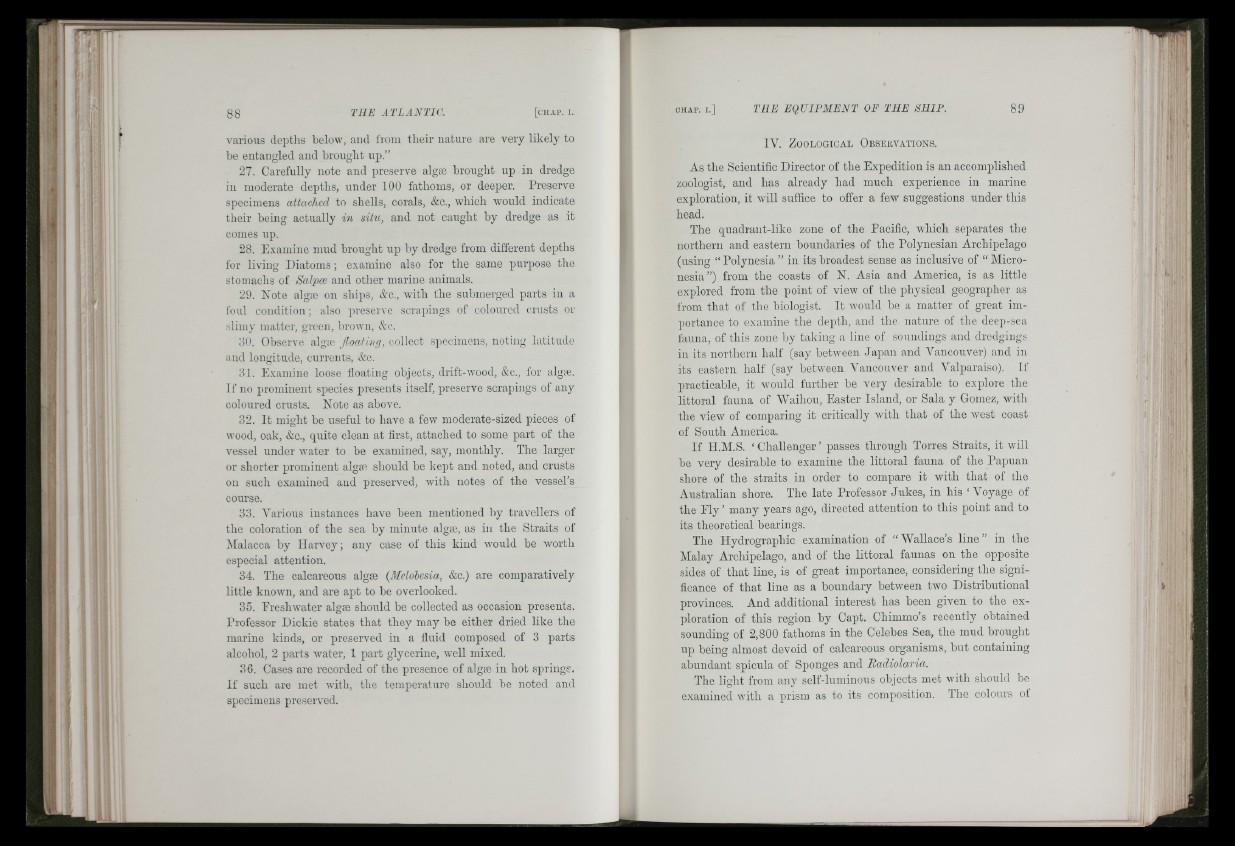
88
, 15 • !
various depths below, and i'roiu their nature are very likely to
he eutaugled and brouglit up.”
27. Carefully note and preserve algre brouglit up . in dredge
in moderate deptlis, under 100 fatlioius, or deeper. Preserve
specimens attached to shells, corals, &c., which would indicate
their heing actually m situ, and not caught by dredge as it
conies np.
28. Examine mud brought up by dredge from different depths
for living Diatoms; examine also for the same purpose tiie
stomaciis of Safce and other marine animals.
29. Note aigfe on sliips, &c., with the submerged parts in a
foul condition; also preserve scrapings of coloured crusts or
.slimy matter, green, hrowii, Vc.
oO. Observe algm floafliifj, collect specimens, noting latitude
and longitude, currents, &c.
31. Examine loose floating objects, drift-wood, &c., for algie..
If no prominent species presents itself, preserve scrapings of any
coloured crusts. Note as above.
32. I t might be useful to have a few moderate-sized pieces of
wood, oak, &c., quite clean at first, attached to some part of the
vessel under water to be examined, say, monthly. The larger
or shorter prominent algm sliould be kept and noted, and crusts
on siicli examined and preserved, with notes of the vessel’s
course.
33. Various instances have heen mentioned by travellers of
the coloration' of the sea by minute algse, as in the Straits of
Malacca by Harvey; any case of this kind would be worth
especial attention.
34. The calcareous algee {Melolesia, &c.) are comparatively
little known, and are apt to be overlooked.
35. Freshwater aigie should be collected as occasion presents.
Professor Dickie states that they may be either dried like the
marine kinds, or preserved in a fluid composed of 3 parts
alcohol, 2 parts water, 1 part glycerine, well mixed.
36. Cases are recorded of the presence of algte in hot springs.
If such are met Avith, tlie temperature sliould be noted and
specimens preserved.
IV. Z o o l o g i c a l O b s e r v a t io n s .
As the Scientific Director of the Expedition is an accomplished
zoologist, and has already had much experience in marine
exploration, it Avill suffice to offer a few suggestions under this
head.
The qiiadrant-like zone of the Pacific, which separates the
northern and eastern boundaries of the Polynesian Archipelago
(using “ Polynesia” in its broadest sense as inclusive of “ Micronesia”)
from the coasts of N. Asia and America, is as little
explored from the point of view of tlie physical geographer as
from that of tiie biologist. I t Avoiild be a matter of great importance
to examine the depth, and tlie nature of tlie deep-sea
fauna, of tills zone hy taking a line of soundings and dredgings
ill its nortliern half (say between Japan and Vancouver) and in
its eastern lialf (say between Vancouver and Valparaiso), if
practicable, it Avould further he very desirable to explore the
littoral fauna of Wailiou, Easter Island, or Sala y Gomez, with
the view of comparing it critically with that of the west coast
of South America.
If H.M.S. ‘ Challenger ’ passes through Torres Straits, it will
he very desirable to examine the littoral fauna of the Papuan
shore of the straits in order to compare it with that of the
Australian shore. The late Professor Jukes, in his ‘Voyage of
the Fly ’ many years ago, directed attention to this point and to
its theoretical bearings.
The Hydrographic examination of “ Wallace’s line ” in the
Malay Archipelago, and of the littoral faunas on the opposite
sides of that line, is of great importance, considering the significance
of that line as a boundary between two Distributional
provinces. And additional interest has been given to the exploration
of this region by Capt. Chimmo’s recently obtained
sounding of 2,800 fathoms in the Celebes Sea, the mud brought
np being almost devoid of calcareous organisms, but containing
abundant spicnla of Sponges and Radiolaria.
The light from any self-luminous objects met with sliould be
examined Avith a prism as to its composition. The colours oi
I A A i
l l " ’ -
■ r r i l
, '-i - 'll i
■ i A. Ajil I
: , ' |4
■iii k